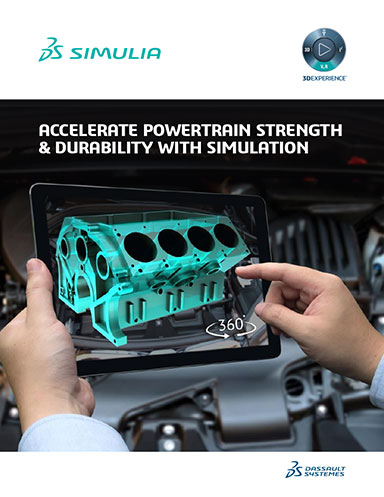Accelerate Powertrain Strength & Durability with Simulation
Simulation can overcome the challenges of designing a powertrain system that is fuel efficient, reliable, and cost-effective while delivering high performance.

November 7, 2019
As the connection between the engine and the wheels, the performance of the powertrain is crucial to the performance of the vehicle as a whole. Optimizing the powertrain maximises engine performance while enhancing fuel economy and reducing emissions.
The powertrain is a complex, heavy system with numerous components, and the demands of delivering power from the engine to the wheels of the car mean those components experience significant stress and wear. Engineers want to minimize weight and friction, while also ensuring the components can withstand the forces acting on it. Smaller and lighter designs are raising new structural challenges, while new technologies place new demands on the powertrain.
This whitepaper shows how structural simulation with SIMULIA software can be used to design, analyze and optimize powertrain components, both in isolation and as in integrated part of the vehicle system.
CHALLENGES IN POWERTRAIN STRENGTH & DURABILITY
Powertrain development can be a time consuming and expensive process. As a result, a lot of emphasis is placed on time-to-market and cost reduction, which in turn can limit how much of the design space the engineer can explore. New materials and manufacturing processes expand the design space further, potentially offering a competitive edge but also requiring new design paradigms.
The continual trend of engine downsizing and component mass reduction improves the performance of the vehicle as a whole, but it also means powertrain engineers are working within ever-tightening limits.
Changing driving styles, such as increased engine speed and start-stop city driving, put more strain on the powertrain components. The use of lower viscosity oils reduces friction and improves fuel economy and winter performance, but requires higher mechanical, structural design in order to maintain the film strength and oil pressure in the high temperature. Direct fuel injection which increases cylinder pressure, also require fundamental changes to powertrain design.
A good design of vehicle’s powertrain will ensure reliability, durability, efficiency, performance, and safety. Structural simulations are key enablers in achieving this objective in a shorter and more cost-effective time than with physical tests. However, the size and complexity of powertrains require software capable of handling such large models. With so many components, powertrain design also requires input from many different teams and departments.
Fill out the information below to download the resource.
Latest News









